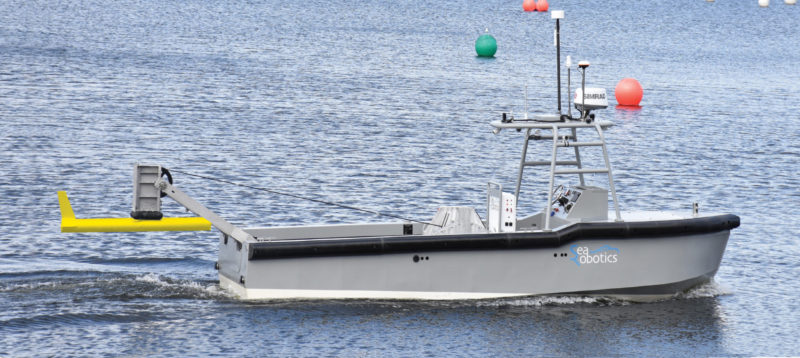SeaRobotics, Stuart, Fla., has completed its factory acceptance testing of its new entry into the autonomous surface vehicle (ASV) workboat market — the SR-Endurance 7.0 meter (22.96') system.
The system is optimized for sonar research through the utilization of an optionally manned helm configuration and a serial diesel electric propulsion system. Outfitted with an instrumented launch and recovery system (LARS), and supporting hydrographic winch system, the SR-Endurance 7.0 is capable of deploying towed sonar/instrument systems, dipping sonar/systems, or ROV systems.
“Having built numerous ASVs in the six-to-11 meter range, we are now offering a commercial workboat for the research and survey markets,” Geoff Douglass, SeaRobotics ASV development manager, said in a statement. “In many operational scenarios the advantages derived from a variable depth sensor such as a multi-beam or side scan sonar, sub bottom profiler, or magnetometer, as well as the surface motion mitigation, make towed systems valuable in autonomous operations.”
With an endurance of up to six days at survey speed and up to 10 hours between automatic battery recharge, the 80-hp, SR-Endurance 7.0’s quiet platform for sonar/sensor research belies its 80-hp strength, company officials said. The multipurpose LARS and payload interface enable the integration of numerous user configured payload systems. A standard 6" pipe flange with cableway is mounted under the hull to provide additional instrument mounting options for additional instruments.
The optionally manned helm enables manned operation in congested waterways and for ramp operations when required. With the flip of a switch, semi-autonomous operations, remote piloting and direct remote-control functionality is provided. Navigation is supported by a pre-programmed, or remotely operated pan/tilt/zoom video system, 360° video coverage with four situation awareness cameras, RADAR, AIS, low bandwidth Iridium, and a high bandwidth line of sight RF link. Many more options are available
The SR-Endurance 7.0 workhorse ASV can be configured with various propulsion configurations. The aluminum general purpose hull offers a large back deck area for mission reconfigurable payloads of various types.
“We were delighted to design and build this new system, one which proved to be of critical importance to the research of the U.S. Naval Research Laboratory (NRL),” said Don Darling, president of SeaRobotics.
SeaRobotics specializes in smart survey vehicles that are manned/unmanned and autonomously operated. The company’s clients include major military and commercial organizations, both U.S. and foreign. SeaRobotics' marine survey software interfaces with most data acquisition hardware, software and sensing systems to produce multi-spectral, geo-referenced data for survey, research or surveillance efforts.
Applications for SeaRobotics vehicles range from bathymetric and hydrographic surveys to coastal, harbor, and riverine surveillance. Many SeaRobotics vessels are small, modular and man-portable, allowing rapid deployment in remote areas or deployment by larger vessels; their command and control systems are user-friendly and compact allowing for safe, efficient surveying.




